The Impact of Digital Technology on SME Business Activity
VerifiedAdded on 2023/01/23
|25
|6260
|26
Report
AI Summary
This research project investigates the impact of digital technology on the business activities of Small and Medium Enterprises (SMEs). The report begins with an introduction outlining the research background, aims, objectives, rationale, and problem statement. The literature review explores recent trends in digital technology affecting SMEs, the advantages these businesses derive from digital implementations, and the challenges they face. The research methodology section details the research methods, approach, design, sampling techniques, data collection processes, and data analysis methods used. The findings are then presented and interpreted, followed by recommendations for addressing the challenges and a reflection on the research process. The report concludes with a summary of the key findings and a list of references, along with an appendix containing the questionnaire used in the research. The study aims to assess how digital technology influences the operations of SMEs, specifically focusing on SDK Jewellers, providing valuable insights into the impact of digitalization on business efficiency and competitiveness.

RESEARCH PROJECT
Paraphrase This Document
Need a fresh take? Get an instant paraphrase of this document with our AI Paraphraser
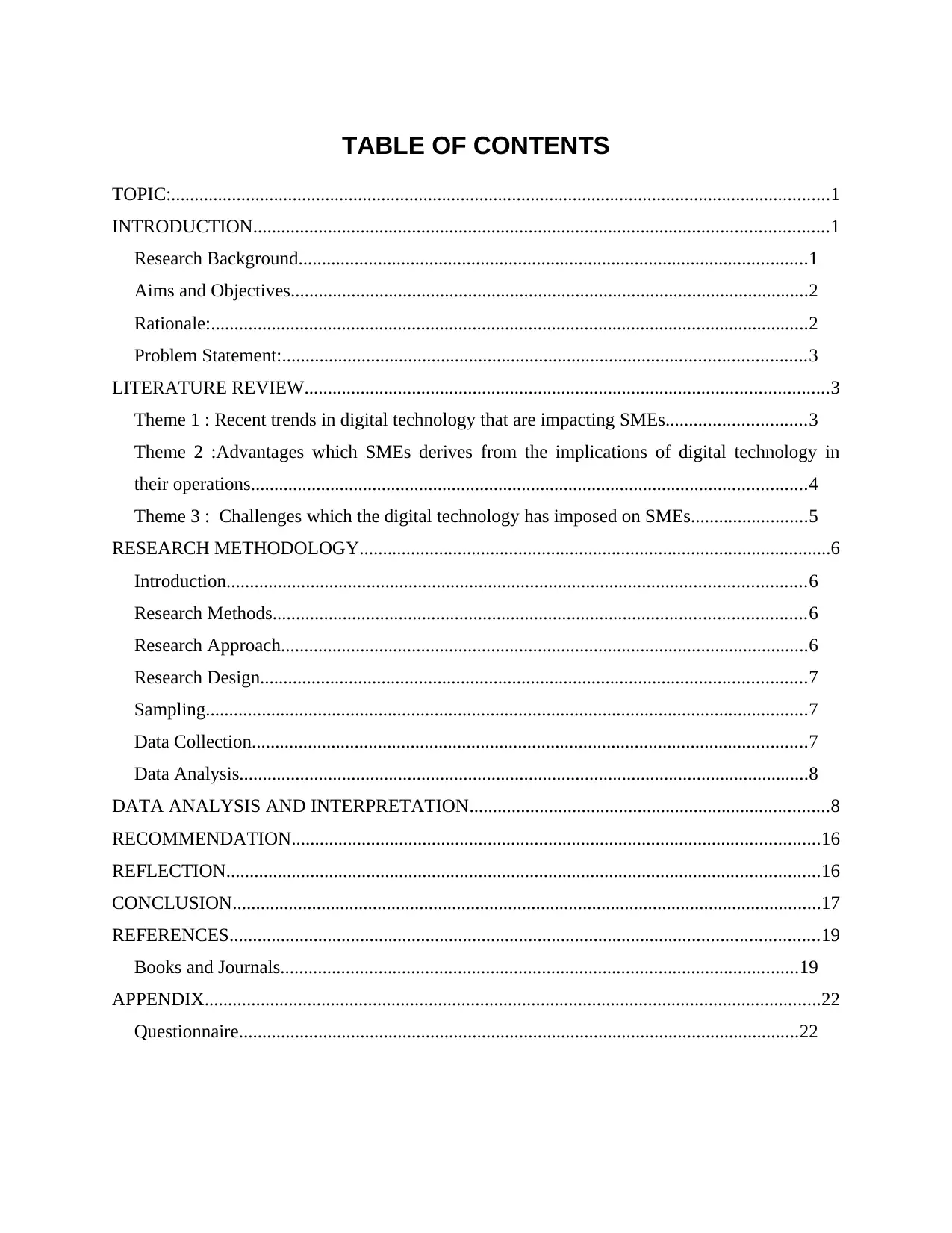
TABLE OF CONTENTS
TOPIC:.............................................................................................................................................1
INTRODUCTION...........................................................................................................................1
Research Background.............................................................................................................1
Aims and Objectives...............................................................................................................2
Rationale:................................................................................................................................2
Problem Statement:................................................................................................................3
LITERATURE REVIEW................................................................................................................3
Theme 1 : Recent trends in digital technology that are impacting SMEs..............................3
Theme 2 :Advantages which SMEs derives from the implications of digital technology in
their operations.......................................................................................................................4
Theme 3 : Challenges which the digital technology has imposed on SMEs.........................5
RESEARCH METHODOLOGY.....................................................................................................6
Introduction............................................................................................................................6
Research Methods..................................................................................................................6
Research Approach.................................................................................................................6
Research Design.....................................................................................................................7
Sampling.................................................................................................................................7
Data Collection.......................................................................................................................7
Data Analysis..........................................................................................................................8
DATA ANALYSIS AND INTERPRETATION.............................................................................8
RECOMMENDATION.................................................................................................................16
REFLECTION...............................................................................................................................16
CONCLUSION..............................................................................................................................17
REFERENCES..............................................................................................................................19
Books and Journals...............................................................................................................19
APPENDIX....................................................................................................................................22
Questionnaire........................................................................................................................22
TOPIC:.............................................................................................................................................1
INTRODUCTION...........................................................................................................................1
Research Background.............................................................................................................1
Aims and Objectives...............................................................................................................2
Rationale:................................................................................................................................2
Problem Statement:................................................................................................................3
LITERATURE REVIEW................................................................................................................3
Theme 1 : Recent trends in digital technology that are impacting SMEs..............................3
Theme 2 :Advantages which SMEs derives from the implications of digital technology in
their operations.......................................................................................................................4
Theme 3 : Challenges which the digital technology has imposed on SMEs.........................5
RESEARCH METHODOLOGY.....................................................................................................6
Introduction............................................................................................................................6
Research Methods..................................................................................................................6
Research Approach.................................................................................................................6
Research Design.....................................................................................................................7
Sampling.................................................................................................................................7
Data Collection.......................................................................................................................7
Data Analysis..........................................................................................................................8
DATA ANALYSIS AND INTERPRETATION.............................................................................8
RECOMMENDATION.................................................................................................................16
REFLECTION...............................................................................................................................16
CONCLUSION..............................................................................................................................17
REFERENCES..............................................................................................................................19
Books and Journals...............................................................................................................19
APPENDIX....................................................................................................................................22
Questionnaire........................................................................................................................22
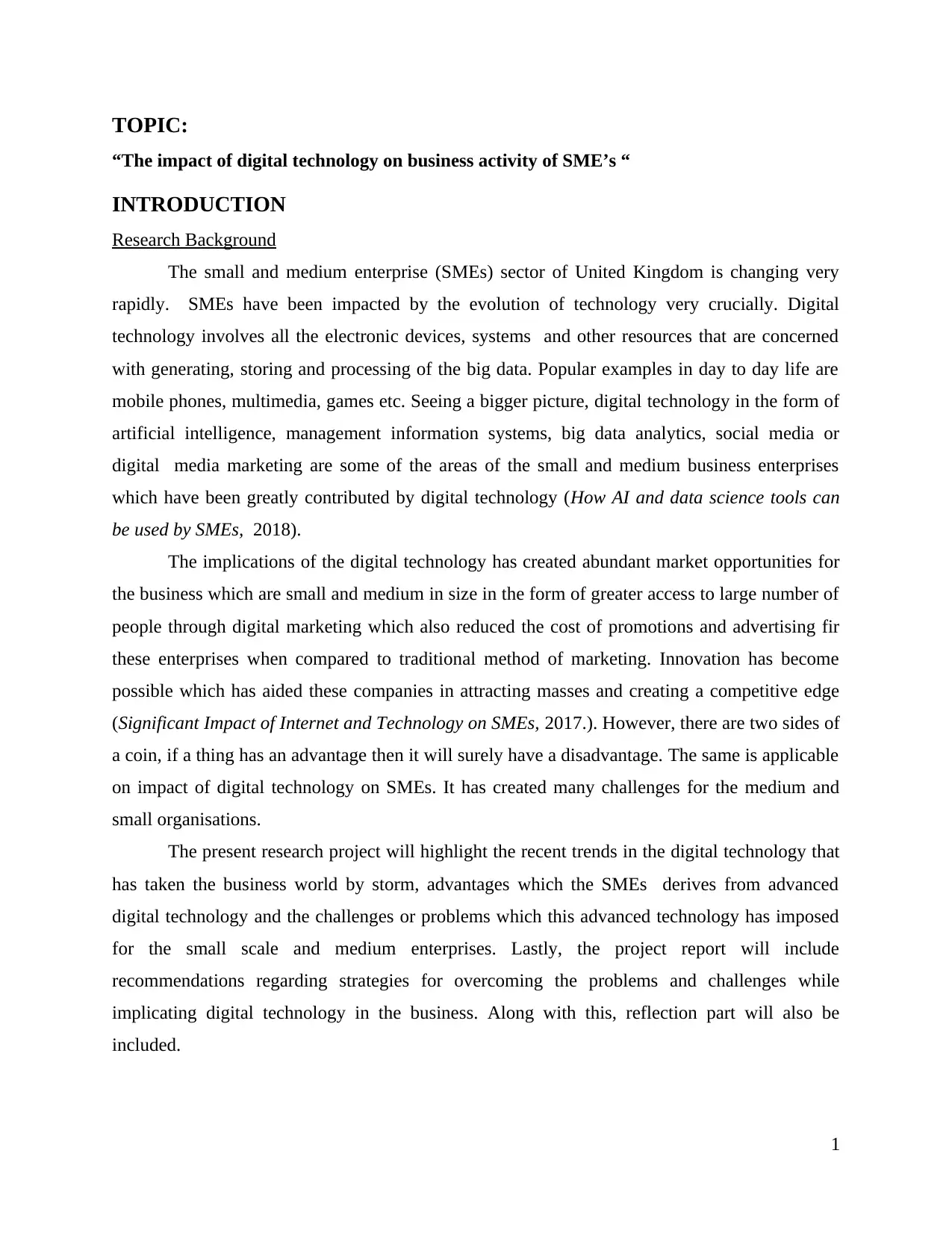
TOPIC:
“The impact of digital technology on business activity of SME’s “
INTRODUCTION
Research Background
The small and medium enterprise (SMEs) sector of United Kingdom is changing very
rapidly. SMEs have been impacted by the evolution of technology very crucially. Digital
technology involves all the electronic devices, systems and other resources that are concerned
with generating, storing and processing of the big data. Popular examples in day to day life are
mobile phones, multimedia, games etc. Seeing a bigger picture, digital technology in the form of
artificial intelligence, management information systems, big data analytics, social media or
digital media marketing are some of the areas of the small and medium business enterprises
which have been greatly contributed by digital technology (How AI and data science tools can
be used by SMEs, 2018).
The implications of the digital technology has created abundant market opportunities for
the business which are small and medium in size in the form of greater access to large number of
people through digital marketing which also reduced the cost of promotions and advertising fir
these enterprises when compared to traditional method of marketing. Innovation has become
possible which has aided these companies in attracting masses and creating a competitive edge
(Significant Impact of Internet and Technology on SMEs, 2017.). However, there are two sides of
a coin, if a thing has an advantage then it will surely have a disadvantage. The same is applicable
on impact of digital technology on SMEs. It has created many challenges for the medium and
small organisations.
The present research project will highlight the recent trends in the digital technology that
has taken the business world by storm, advantages which the SMEs derives from advanced
digital technology and the challenges or problems which this advanced technology has imposed
for the small scale and medium enterprises. Lastly, the project report will include
recommendations regarding strategies for overcoming the problems and challenges while
implicating digital technology in the business. Along with this, reflection part will also be
included.
1
“The impact of digital technology on business activity of SME’s “
INTRODUCTION
Research Background
The small and medium enterprise (SMEs) sector of United Kingdom is changing very
rapidly. SMEs have been impacted by the evolution of technology very crucially. Digital
technology involves all the electronic devices, systems and other resources that are concerned
with generating, storing and processing of the big data. Popular examples in day to day life are
mobile phones, multimedia, games etc. Seeing a bigger picture, digital technology in the form of
artificial intelligence, management information systems, big data analytics, social media or
digital media marketing are some of the areas of the small and medium business enterprises
which have been greatly contributed by digital technology (How AI and data science tools can
be used by SMEs, 2018).
The implications of the digital technology has created abundant market opportunities for
the business which are small and medium in size in the form of greater access to large number of
people through digital marketing which also reduced the cost of promotions and advertising fir
these enterprises when compared to traditional method of marketing. Innovation has become
possible which has aided these companies in attracting masses and creating a competitive edge
(Significant Impact of Internet and Technology on SMEs, 2017.). However, there are two sides of
a coin, if a thing has an advantage then it will surely have a disadvantage. The same is applicable
on impact of digital technology on SMEs. It has created many challenges for the medium and
small organisations.
The present research project will highlight the recent trends in the digital technology that
has taken the business world by storm, advantages which the SMEs derives from advanced
digital technology and the challenges or problems which this advanced technology has imposed
for the small scale and medium enterprises. Lastly, the project report will include
recommendations regarding strategies for overcoming the problems and challenges while
implicating digital technology in the business. Along with this, reflection part will also be
included.
1
⊘ This is a preview!⊘
Do you want full access?
Subscribe today to unlock all pages.

Trusted by 1+ million students worldwide
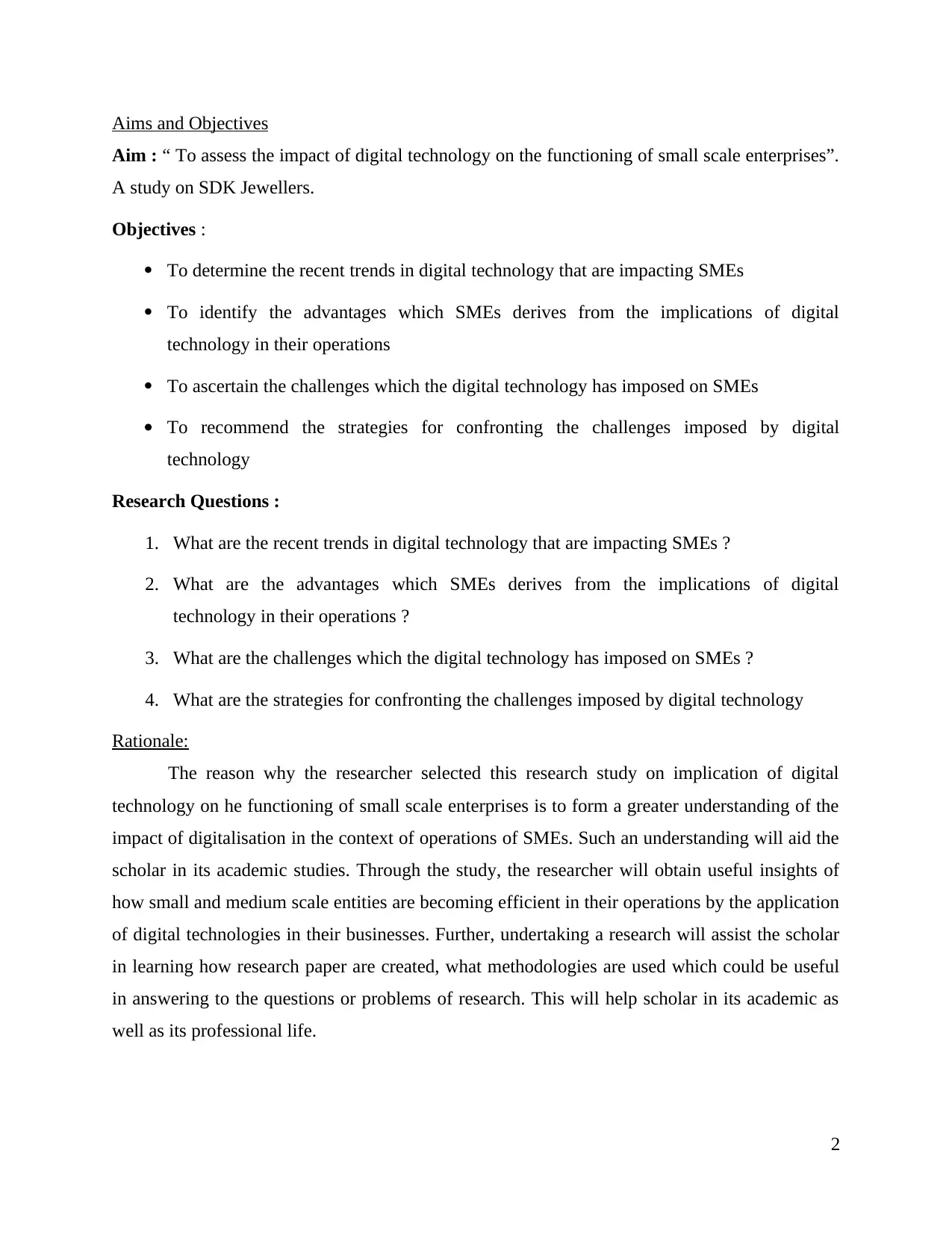
Aims and Objectives
Aim : “ To assess the impact of digital technology on the functioning of small scale enterprises”.
A study on SDK Jewellers.
Objectives :
To determine the recent trends in digital technology that are impacting SMEs
To identify the advantages which SMEs derives from the implications of digital
technology in their operations
To ascertain the challenges which the digital technology has imposed on SMEs
To recommend the strategies for confronting the challenges imposed by digital
technology
Research Questions :
1. What are the recent trends in digital technology that are impacting SMEs ?
2. What are the advantages which SMEs derives from the implications of digital
technology in their operations ?
3. What are the challenges which the digital technology has imposed on SMEs ?
4. What are the strategies for confronting the challenges imposed by digital technology
Rationale:
The reason why the researcher selected this research study on implication of digital
technology on he functioning of small scale enterprises is to form a greater understanding of the
impact of digitalisation in the context of operations of SMEs. Such an understanding will aid the
scholar in its academic studies. Through the study, the researcher will obtain useful insights of
how small and medium scale entities are becoming efficient in their operations by the application
of digital technologies in their businesses. Further, undertaking a research will assist the scholar
in learning how research paper are created, what methodologies are used which could be useful
in answering to the questions or problems of research. This will help scholar in its academic as
well as its professional life.
2
Aim : “ To assess the impact of digital technology on the functioning of small scale enterprises”.
A study on SDK Jewellers.
Objectives :
To determine the recent trends in digital technology that are impacting SMEs
To identify the advantages which SMEs derives from the implications of digital
technology in their operations
To ascertain the challenges which the digital technology has imposed on SMEs
To recommend the strategies for confronting the challenges imposed by digital
technology
Research Questions :
1. What are the recent trends in digital technology that are impacting SMEs ?
2. What are the advantages which SMEs derives from the implications of digital
technology in their operations ?
3. What are the challenges which the digital technology has imposed on SMEs ?
4. What are the strategies for confronting the challenges imposed by digital technology
Rationale:
The reason why the researcher selected this research study on implication of digital
technology on he functioning of small scale enterprises is to form a greater understanding of the
impact of digitalisation in the context of operations of SMEs. Such an understanding will aid the
scholar in its academic studies. Through the study, the researcher will obtain useful insights of
how small and medium scale entities are becoming efficient in their operations by the application
of digital technologies in their businesses. Further, undertaking a research will assist the scholar
in learning how research paper are created, what methodologies are used which could be useful
in answering to the questions or problems of research. This will help scholar in its academic as
well as its professional life.
2
Paraphrase This Document
Need a fresh take? Get an instant paraphrase of this document with our AI Paraphraser
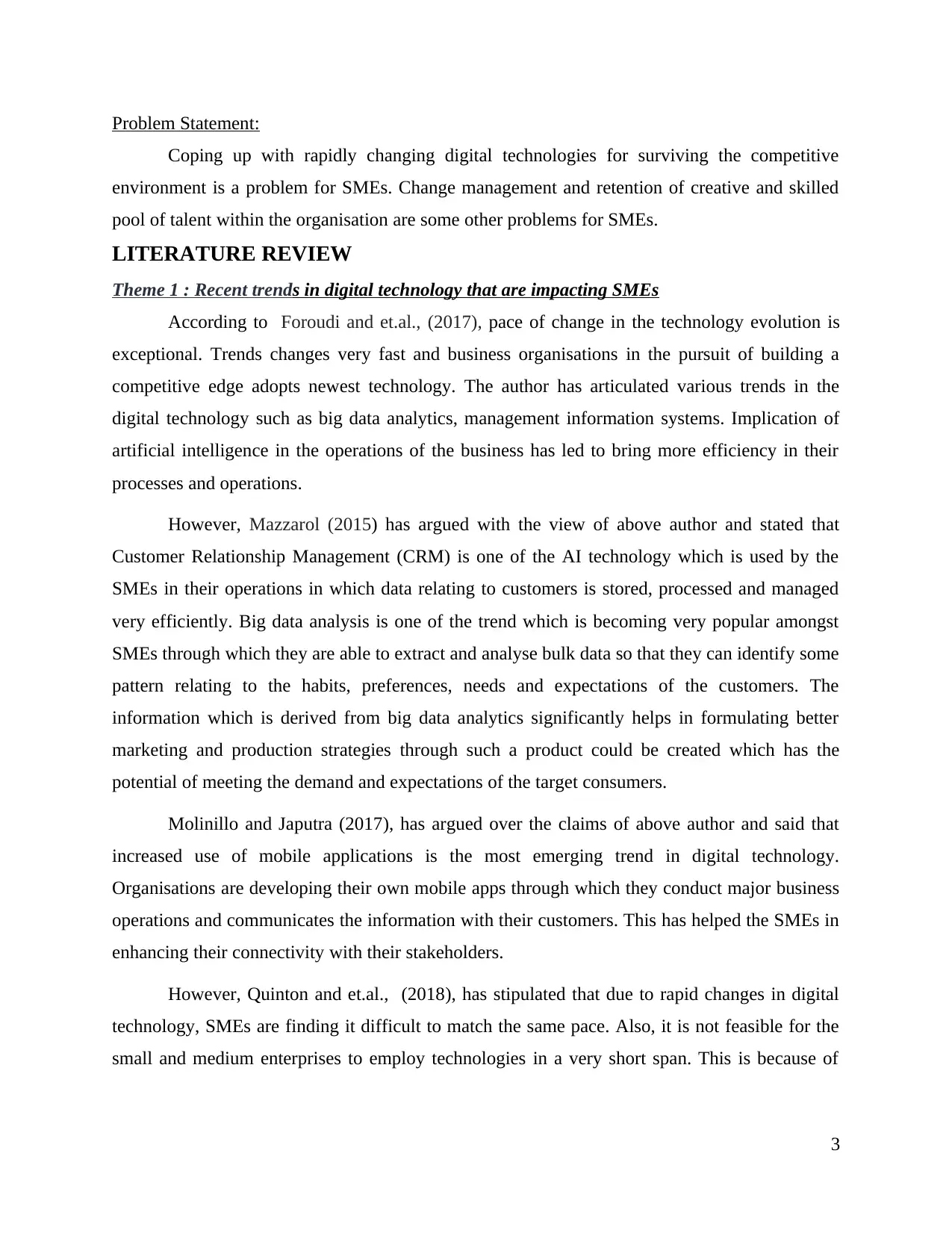
Problem Statement:
Coping up with rapidly changing digital technologies for surviving the competitive
environment is a problem for SMEs. Change management and retention of creative and skilled
pool of talent within the organisation are some other problems for SMEs.
LITERATURE REVIEW
Theme 1 : Recent trends in digital technology that are impacting SMEs
According to Foroudi and et.al., (2017), pace of change in the technology evolution is
exceptional. Trends changes very fast and business organisations in the pursuit of building a
competitive edge adopts newest technology. The author has articulated various trends in the
digital technology such as big data analytics, management information systems. Implication of
artificial intelligence in the operations of the business has led to bring more efficiency in their
processes and operations.
However, Mazzarol (2015) has argued with the view of above author and stated that
Customer Relationship Management (CRM) is one of the AI technology which is used by the
SMEs in their operations in which data relating to customers is stored, processed and managed
very efficiently. Big data analysis is one of the trend which is becoming very popular amongst
SMEs through which they are able to extract and analyse bulk data so that they can identify some
pattern relating to the habits, preferences, needs and expectations of the customers. The
information which is derived from big data analytics significantly helps in formulating better
marketing and production strategies through such a product could be created which has the
potential of meeting the demand and expectations of the target consumers.
Molinillo and Japutra (2017), has argued over the claims of above author and said that
increased use of mobile applications is the most emerging trend in digital technology.
Organisations are developing their own mobile apps through which they conduct major business
operations and communicates the information with their customers. This has helped the SMEs in
enhancing their connectivity with their stakeholders.
However, Quinton and et.al., (2018), has stipulated that due to rapid changes in digital
technology, SMEs are finding it difficult to match the same pace. Also, it is not feasible for the
small and medium enterprises to employ technologies in a very short span. This is because of
3
Coping up with rapidly changing digital technologies for surviving the competitive
environment is a problem for SMEs. Change management and retention of creative and skilled
pool of talent within the organisation are some other problems for SMEs.
LITERATURE REVIEW
Theme 1 : Recent trends in digital technology that are impacting SMEs
According to Foroudi and et.al., (2017), pace of change in the technology evolution is
exceptional. Trends changes very fast and business organisations in the pursuit of building a
competitive edge adopts newest technology. The author has articulated various trends in the
digital technology such as big data analytics, management information systems. Implication of
artificial intelligence in the operations of the business has led to bring more efficiency in their
processes and operations.
However, Mazzarol (2015) has argued with the view of above author and stated that
Customer Relationship Management (CRM) is one of the AI technology which is used by the
SMEs in their operations in which data relating to customers is stored, processed and managed
very efficiently. Big data analysis is one of the trend which is becoming very popular amongst
SMEs through which they are able to extract and analyse bulk data so that they can identify some
pattern relating to the habits, preferences, needs and expectations of the customers. The
information which is derived from big data analytics significantly helps in formulating better
marketing and production strategies through such a product could be created which has the
potential of meeting the demand and expectations of the target consumers.
Molinillo and Japutra (2017), has argued over the claims of above author and said that
increased use of mobile applications is the most emerging trend in digital technology.
Organisations are developing their own mobile apps through which they conduct major business
operations and communicates the information with their customers. This has helped the SMEs in
enhancing their connectivity with their stakeholders.
However, Quinton and et.al., (2018), has stipulated that due to rapid changes in digital
technology, SMEs are finding it difficult to match the same pace. Also, it is not feasible for the
small and medium enterprises to employ technologies in a very short span. This is because of
3
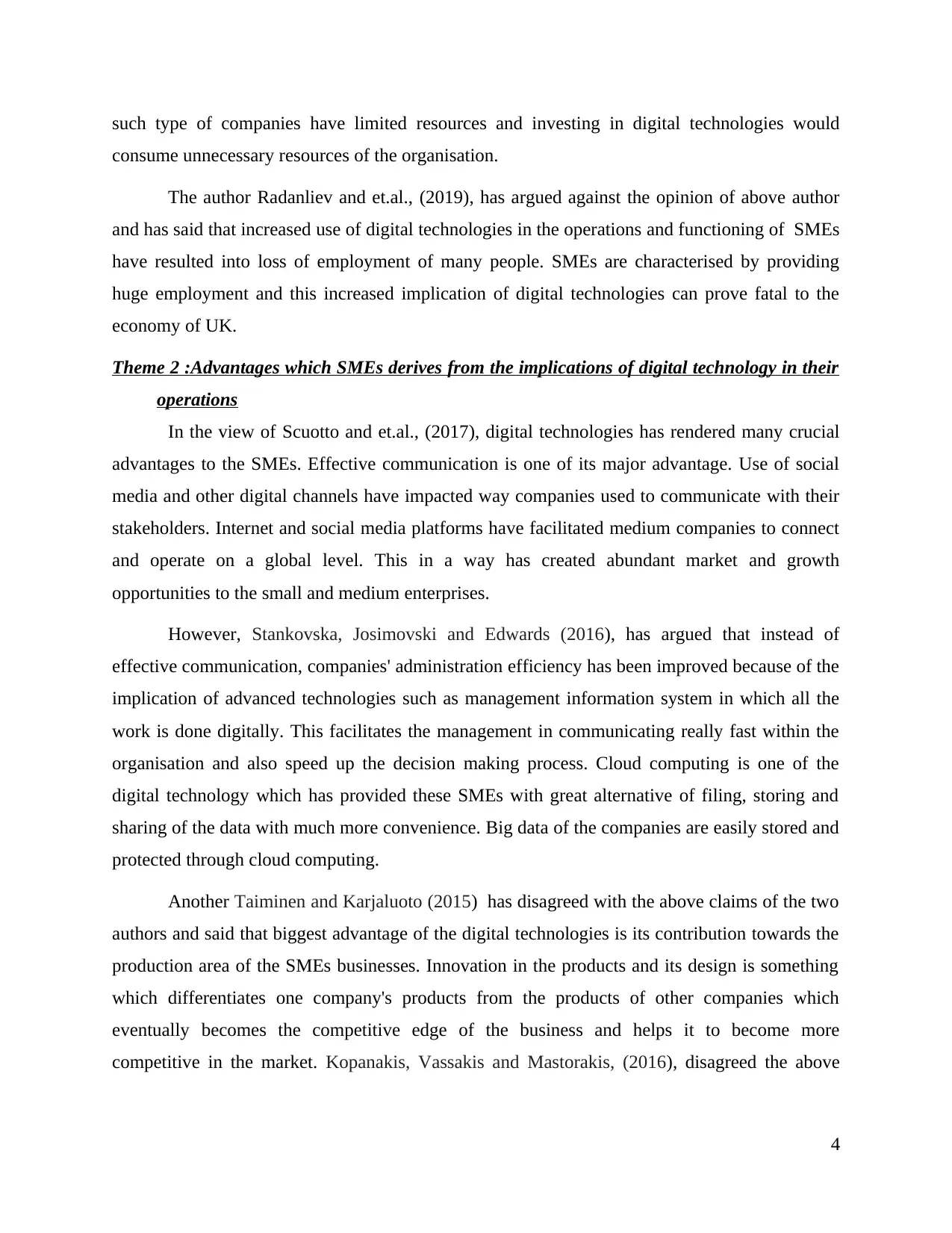
such type of companies have limited resources and investing in digital technologies would
consume unnecessary resources of the organisation.
The author Radanliev and et.al., (2019), has argued against the opinion of above author
and has said that increased use of digital technologies in the operations and functioning of SMEs
have resulted into loss of employment of many people. SMEs are characterised by providing
huge employment and this increased implication of digital technologies can prove fatal to the
economy of UK.
Theme 2 :Advantages which SMEs derives from the implications of digital technology in their
operations
In the view of Scuotto and et.al., (2017), digital technologies has rendered many crucial
advantages to the SMEs. Effective communication is one of its major advantage. Use of social
media and other digital channels have impacted way companies used to communicate with their
stakeholders. Internet and social media platforms have facilitated medium companies to connect
and operate on a global level. This in a way has created abundant market and growth
opportunities to the small and medium enterprises.
However, Stankovska, Josimovski and Edwards (2016), has argued that instead of
effective communication, companies' administration efficiency has been improved because of the
implication of advanced technologies such as management information system in which all the
work is done digitally. This facilitates the management in communicating really fast within the
organisation and also speed up the decision making process. Cloud computing is one of the
digital technology which has provided these SMEs with great alternative of filing, storing and
sharing of the data with much more convenience. Big data of the companies are easily stored and
protected through cloud computing.
Another Taiminen and Karjaluoto (2015) has disagreed with the above claims of the two
authors and said that biggest advantage of the digital technologies is its contribution towards the
production area of the SMEs businesses. Innovation in the products and its design is something
which differentiates one company's products from the products of other companies which
eventually becomes the competitive edge of the business and helps it to become more
competitive in the market. Kopanakis, Vassakis and Mastorakis, (2016), disagreed the above
4
consume unnecessary resources of the organisation.
The author Radanliev and et.al., (2019), has argued against the opinion of above author
and has said that increased use of digital technologies in the operations and functioning of SMEs
have resulted into loss of employment of many people. SMEs are characterised by providing
huge employment and this increased implication of digital technologies can prove fatal to the
economy of UK.
Theme 2 :Advantages which SMEs derives from the implications of digital technology in their
operations
In the view of Scuotto and et.al., (2017), digital technologies has rendered many crucial
advantages to the SMEs. Effective communication is one of its major advantage. Use of social
media and other digital channels have impacted way companies used to communicate with their
stakeholders. Internet and social media platforms have facilitated medium companies to connect
and operate on a global level. This in a way has created abundant market and growth
opportunities to the small and medium enterprises.
However, Stankovska, Josimovski and Edwards (2016), has argued that instead of
effective communication, companies' administration efficiency has been improved because of the
implication of advanced technologies such as management information system in which all the
work is done digitally. This facilitates the management in communicating really fast within the
organisation and also speed up the decision making process. Cloud computing is one of the
digital technology which has provided these SMEs with great alternative of filing, storing and
sharing of the data with much more convenience. Big data of the companies are easily stored and
protected through cloud computing.
Another Taiminen and Karjaluoto (2015) has disagreed with the above claims of the two
authors and said that biggest advantage of the digital technologies is its contribution towards the
production area of the SMEs businesses. Innovation in the products and its design is something
which differentiates one company's products from the products of other companies which
eventually becomes the competitive edge of the business and helps it to become more
competitive in the market. Kopanakis, Vassakis and Mastorakis, (2016), disagreed the above
4
⊘ This is a preview!⊘
Do you want full access?
Subscribe today to unlock all pages.

Trusted by 1+ million students worldwide
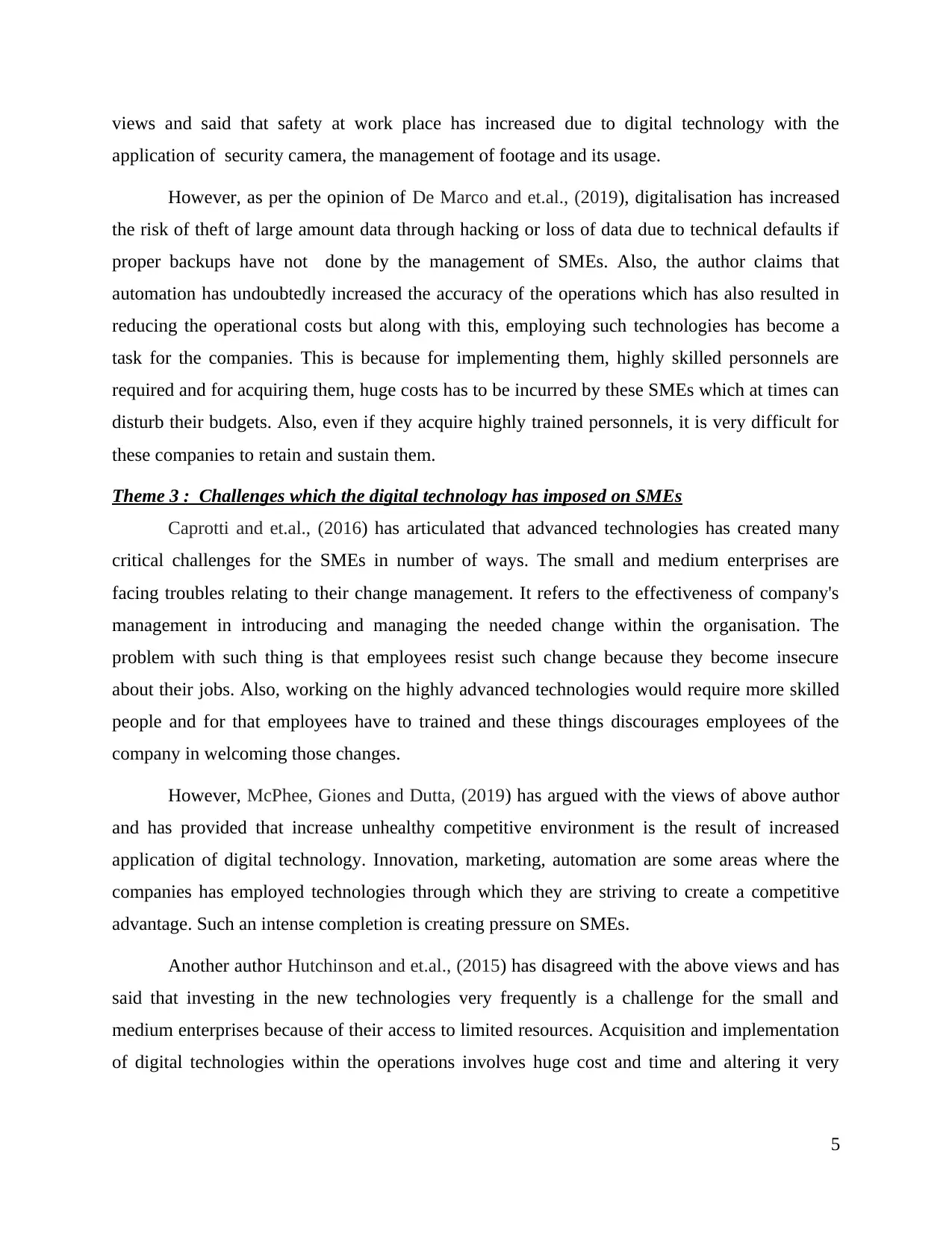
views and said that safety at work place has increased due to digital technology with the
application of security camera, the management of footage and its usage.
However, as per the opinion of De Marco and et.al., (2019), digitalisation has increased
the risk of theft of large amount data through hacking or loss of data due to technical defaults if
proper backups have not done by the management of SMEs. Also, the author claims that
automation has undoubtedly increased the accuracy of the operations which has also resulted in
reducing the operational costs but along with this, employing such technologies has become a
task for the companies. This is because for implementing them, highly skilled personnels are
required and for acquiring them, huge costs has to be incurred by these SMEs which at times can
disturb their budgets. Also, even if they acquire highly trained personnels, it is very difficult for
these companies to retain and sustain them.
Theme 3 : Challenges which the digital technology has imposed on SMEs
Caprotti and et.al., (2016) has articulated that advanced technologies has created many
critical challenges for the SMEs in number of ways. The small and medium enterprises are
facing troubles relating to their change management. It refers to the effectiveness of company's
management in introducing and managing the needed change within the organisation. The
problem with such thing is that employees resist such change because they become insecure
about their jobs. Also, working on the highly advanced technologies would require more skilled
people and for that employees have to trained and these things discourages employees of the
company in welcoming those changes.
However, McPhee, Giones and Dutta, (2019) has argued with the views of above author
and has provided that increase unhealthy competitive environment is the result of increased
application of digital technology. Innovation, marketing, automation are some areas where the
companies has employed technologies through which they are striving to create a competitive
advantage. Such an intense completion is creating pressure on SMEs.
Another author Hutchinson and et.al., (2015) has disagreed with the above views and has
said that investing in the new technologies very frequently is a challenge for the small and
medium enterprises because of their access to limited resources. Acquisition and implementation
of digital technologies within the operations involves huge cost and time and altering it very
5
application of security camera, the management of footage and its usage.
However, as per the opinion of De Marco and et.al., (2019), digitalisation has increased
the risk of theft of large amount data through hacking or loss of data due to technical defaults if
proper backups have not done by the management of SMEs. Also, the author claims that
automation has undoubtedly increased the accuracy of the operations which has also resulted in
reducing the operational costs but along with this, employing such technologies has become a
task for the companies. This is because for implementing them, highly skilled personnels are
required and for acquiring them, huge costs has to be incurred by these SMEs which at times can
disturb their budgets. Also, even if they acquire highly trained personnels, it is very difficult for
these companies to retain and sustain them.
Theme 3 : Challenges which the digital technology has imposed on SMEs
Caprotti and et.al., (2016) has articulated that advanced technologies has created many
critical challenges for the SMEs in number of ways. The small and medium enterprises are
facing troubles relating to their change management. It refers to the effectiveness of company's
management in introducing and managing the needed change within the organisation. The
problem with such thing is that employees resist such change because they become insecure
about their jobs. Also, working on the highly advanced technologies would require more skilled
people and for that employees have to trained and these things discourages employees of the
company in welcoming those changes.
However, McPhee, Giones and Dutta, (2019) has argued with the views of above author
and has provided that increase unhealthy competitive environment is the result of increased
application of digital technology. Innovation, marketing, automation are some areas where the
companies has employed technologies through which they are striving to create a competitive
advantage. Such an intense completion is creating pressure on SMEs.
Another author Hutchinson and et.al., (2015) has disagreed with the above views and has
said that investing in the new technologies very frequently is a challenge for the small and
medium enterprises because of their access to limited resources. Acquisition and implementation
of digital technologies within the operations involves huge cost and time and altering it very
5
Paraphrase This Document
Need a fresh take? Get an instant paraphrase of this document with our AI Paraphraser
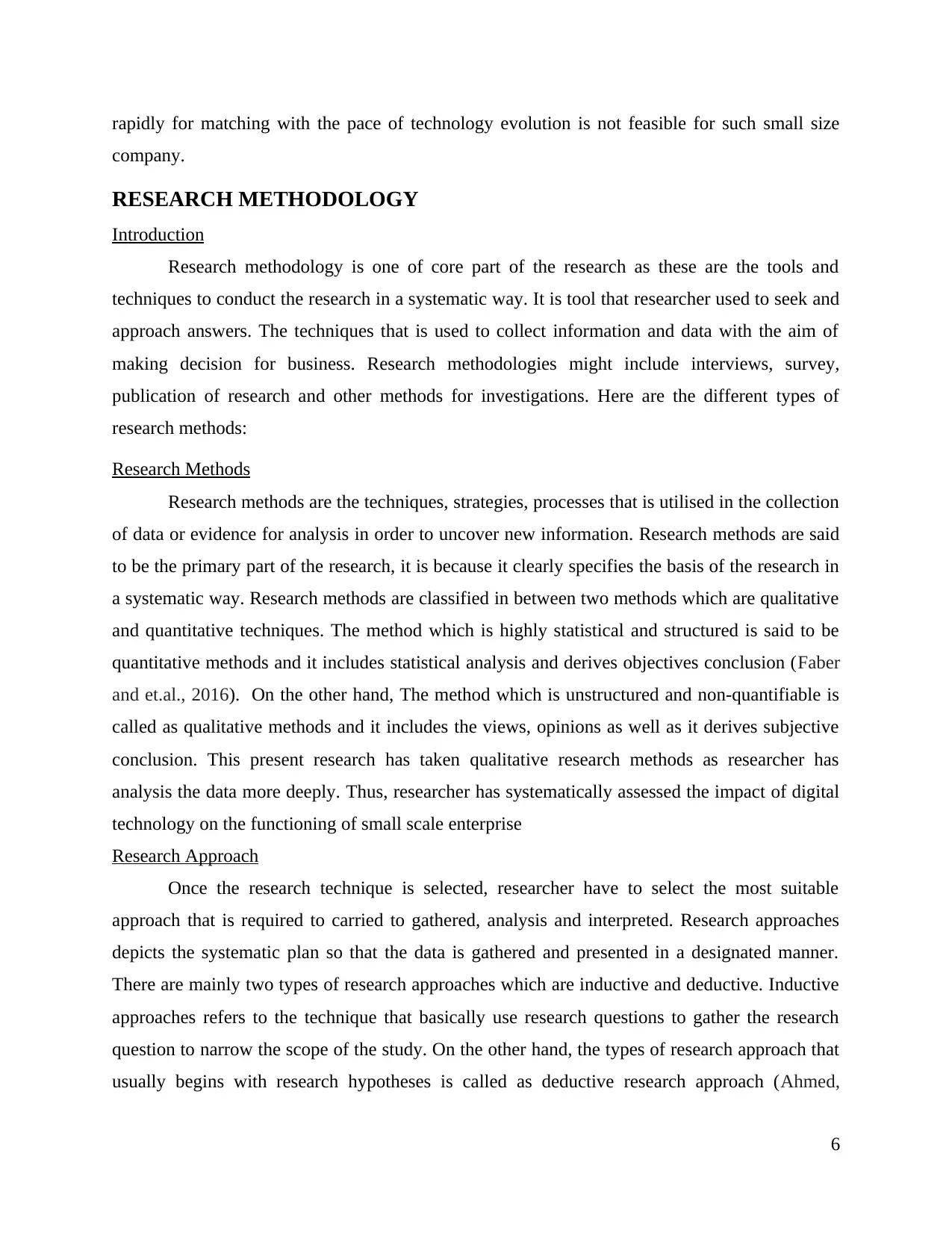
rapidly for matching with the pace of technology evolution is not feasible for such small size
company.
RESEARCH METHODOLOGY
Introduction
Research methodology is one of core part of the research as these are the tools and
techniques to conduct the research in a systematic way. It is tool that researcher used to seek and
approach answers. The techniques that is used to collect information and data with the aim of
making decision for business. Research methodologies might include interviews, survey,
publication of research and other methods for investigations. Here are the different types of
research methods:
Research Methods
Research methods are the techniques, strategies, processes that is utilised in the collection
of data or evidence for analysis in order to uncover new information. Research methods are said
to be the primary part of the research, it is because it clearly specifies the basis of the research in
a systematic way. Research methods are classified in between two methods which are qualitative
and quantitative techniques. The method which is highly statistical and structured is said to be
quantitative methods and it includes statistical analysis and derives objectives conclusion (Faber
and et.al., 2016). On the other hand, The method which is unstructured and non-quantifiable is
called as qualitative methods and it includes the views, opinions as well as it derives subjective
conclusion. This present research has taken qualitative research methods as researcher has
analysis the data more deeply. Thus, researcher has systematically assessed the impact of digital
technology on the functioning of small scale enterprise
Research Approach
Once the research technique is selected, researcher have to select the most suitable
approach that is required to carried to gathered, analysis and interpreted. Research approaches
depicts the systematic plan so that the data is gathered and presented in a designated manner.
There are mainly two types of research approaches which are inductive and deductive. Inductive
approaches refers to the technique that basically use research questions to gather the research
question to narrow the scope of the study. On the other hand, the types of research approach that
usually begins with research hypotheses is called as deductive research approach (Ahmed,
6
company.
RESEARCH METHODOLOGY
Introduction
Research methodology is one of core part of the research as these are the tools and
techniques to conduct the research in a systematic way. It is tool that researcher used to seek and
approach answers. The techniques that is used to collect information and data with the aim of
making decision for business. Research methodologies might include interviews, survey,
publication of research and other methods for investigations. Here are the different types of
research methods:
Research Methods
Research methods are the techniques, strategies, processes that is utilised in the collection
of data or evidence for analysis in order to uncover new information. Research methods are said
to be the primary part of the research, it is because it clearly specifies the basis of the research in
a systematic way. Research methods are classified in between two methods which are qualitative
and quantitative techniques. The method which is highly statistical and structured is said to be
quantitative methods and it includes statistical analysis and derives objectives conclusion (Faber
and et.al., 2016). On the other hand, The method which is unstructured and non-quantifiable is
called as qualitative methods and it includes the views, opinions as well as it derives subjective
conclusion. This present research has taken qualitative research methods as researcher has
analysis the data more deeply. Thus, researcher has systematically assessed the impact of digital
technology on the functioning of small scale enterprise
Research Approach
Once the research technique is selected, researcher have to select the most suitable
approach that is required to carried to gathered, analysis and interpreted. Research approaches
depicts the systematic plan so that the data is gathered and presented in a designated manner.
There are mainly two types of research approaches which are inductive and deductive. Inductive
approaches refers to the technique that basically use research questions to gather the research
question to narrow the scope of the study. On the other hand, the types of research approach that
usually begins with research hypotheses is called as deductive research approach (Ahmed,
6
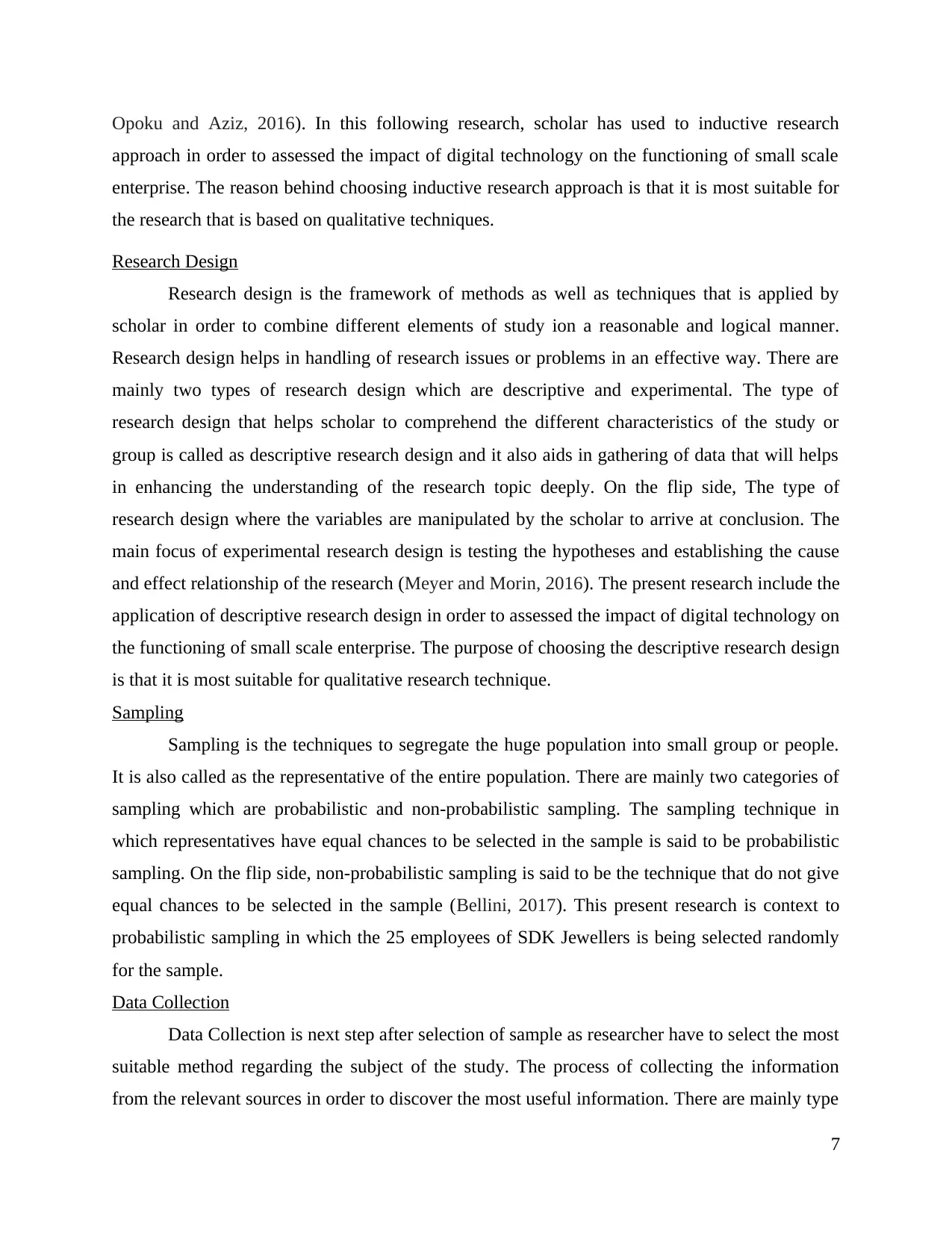
Opoku and Aziz, 2016). In this following research, scholar has used to inductive research
approach in order to assessed the impact of digital technology on the functioning of small scale
enterprise. The reason behind choosing inductive research approach is that it is most suitable for
the research that is based on qualitative techniques.
Research Design
Research design is the framework of methods as well as techniques that is applied by
scholar in order to combine different elements of study ion a reasonable and logical manner.
Research design helps in handling of research issues or problems in an effective way. There are
mainly two types of research design which are descriptive and experimental. The type of
research design that helps scholar to comprehend the different characteristics of the study or
group is called as descriptive research design and it also aids in gathering of data that will helps
in enhancing the understanding of the research topic deeply. On the flip side, The type of
research design where the variables are manipulated by the scholar to arrive at conclusion. The
main focus of experimental research design is testing the hypotheses and establishing the cause
and effect relationship of the research (Meyer and Morin, 2016). The present research include the
application of descriptive research design in order to assessed the impact of digital technology on
the functioning of small scale enterprise. The purpose of choosing the descriptive research design
is that it is most suitable for qualitative research technique.
Sampling
Sampling is the techniques to segregate the huge population into small group or people.
It is also called as the representative of the entire population. There are mainly two categories of
sampling which are probabilistic and non-probabilistic sampling. The sampling technique in
which representatives have equal chances to be selected in the sample is said to be probabilistic
sampling. On the flip side, non-probabilistic sampling is said to be the technique that do not give
equal chances to be selected in the sample (Bellini, 2017). This present research is context to
probabilistic sampling in which the 25 employees of SDK Jewellers is being selected randomly
for the sample.
Data Collection
Data Collection is next step after selection of sample as researcher have to select the most
suitable method regarding the subject of the study. The process of collecting the information
from the relevant sources in order to discover the most useful information. There are mainly type
7
approach in order to assessed the impact of digital technology on the functioning of small scale
enterprise. The reason behind choosing inductive research approach is that it is most suitable for
the research that is based on qualitative techniques.
Research Design
Research design is the framework of methods as well as techniques that is applied by
scholar in order to combine different elements of study ion a reasonable and logical manner.
Research design helps in handling of research issues or problems in an effective way. There are
mainly two types of research design which are descriptive and experimental. The type of
research design that helps scholar to comprehend the different characteristics of the study or
group is called as descriptive research design and it also aids in gathering of data that will helps
in enhancing the understanding of the research topic deeply. On the flip side, The type of
research design where the variables are manipulated by the scholar to arrive at conclusion. The
main focus of experimental research design is testing the hypotheses and establishing the cause
and effect relationship of the research (Meyer and Morin, 2016). The present research include the
application of descriptive research design in order to assessed the impact of digital technology on
the functioning of small scale enterprise. The purpose of choosing the descriptive research design
is that it is most suitable for qualitative research technique.
Sampling
Sampling is the techniques to segregate the huge population into small group or people.
It is also called as the representative of the entire population. There are mainly two categories of
sampling which are probabilistic and non-probabilistic sampling. The sampling technique in
which representatives have equal chances to be selected in the sample is said to be probabilistic
sampling. On the flip side, non-probabilistic sampling is said to be the technique that do not give
equal chances to be selected in the sample (Bellini, 2017). This present research is context to
probabilistic sampling in which the 25 employees of SDK Jewellers is being selected randomly
for the sample.
Data Collection
Data Collection is next step after selection of sample as researcher have to select the most
suitable method regarding the subject of the study. The process of collecting the information
from the relevant sources in order to discover the most useful information. There are mainly type
7
⊘ This is a preview!⊘
Do you want full access?
Subscribe today to unlock all pages.

Trusted by 1+ million students worldwide
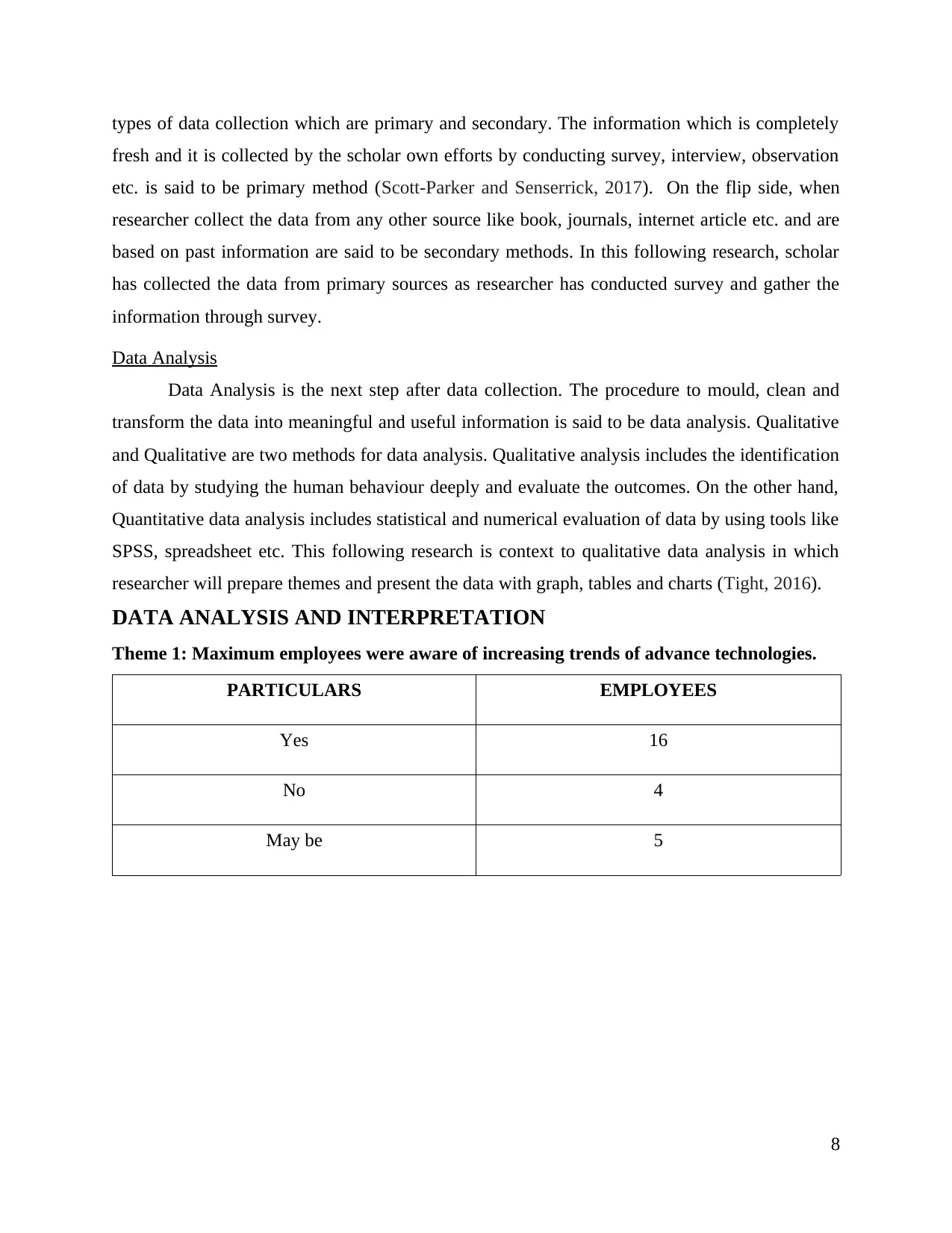
types of data collection which are primary and secondary. The information which is completely
fresh and it is collected by the scholar own efforts by conducting survey, interview, observation
etc. is said to be primary method (Scott-Parker and Senserrick, 2017). On the flip side, when
researcher collect the data from any other source like book, journals, internet article etc. and are
based on past information are said to be secondary methods. In this following research, scholar
has collected the data from primary sources as researcher has conducted survey and gather the
information through survey.
Data Analysis
Data Analysis is the next step after data collection. The procedure to mould, clean and
transform the data into meaningful and useful information is said to be data analysis. Qualitative
and Qualitative are two methods for data analysis. Qualitative analysis includes the identification
of data by studying the human behaviour deeply and evaluate the outcomes. On the other hand,
Quantitative data analysis includes statistical and numerical evaluation of data by using tools like
SPSS, spreadsheet etc. This following research is context to qualitative data analysis in which
researcher will prepare themes and present the data with graph, tables and charts (Tight, 2016).
DATA ANALYSIS AND INTERPRETATION
Theme 1: Maximum employees were aware of increasing trends of advance technologies.
PARTICULARS EMPLOYEES
Yes 16
No 4
May be 5
8
fresh and it is collected by the scholar own efforts by conducting survey, interview, observation
etc. is said to be primary method (Scott-Parker and Senserrick, 2017). On the flip side, when
researcher collect the data from any other source like book, journals, internet article etc. and are
based on past information are said to be secondary methods. In this following research, scholar
has collected the data from primary sources as researcher has conducted survey and gather the
information through survey.
Data Analysis
Data Analysis is the next step after data collection. The procedure to mould, clean and
transform the data into meaningful and useful information is said to be data analysis. Qualitative
and Qualitative are two methods for data analysis. Qualitative analysis includes the identification
of data by studying the human behaviour deeply and evaluate the outcomes. On the other hand,
Quantitative data analysis includes statistical and numerical evaluation of data by using tools like
SPSS, spreadsheet etc. This following research is context to qualitative data analysis in which
researcher will prepare themes and present the data with graph, tables and charts (Tight, 2016).
DATA ANALYSIS AND INTERPRETATION
Theme 1: Maximum employees were aware of increasing trends of advance technologies.
PARTICULARS EMPLOYEES
Yes 16
No 4
May be 5
8
Paraphrase This Document
Need a fresh take? Get an instant paraphrase of this document with our AI Paraphraser
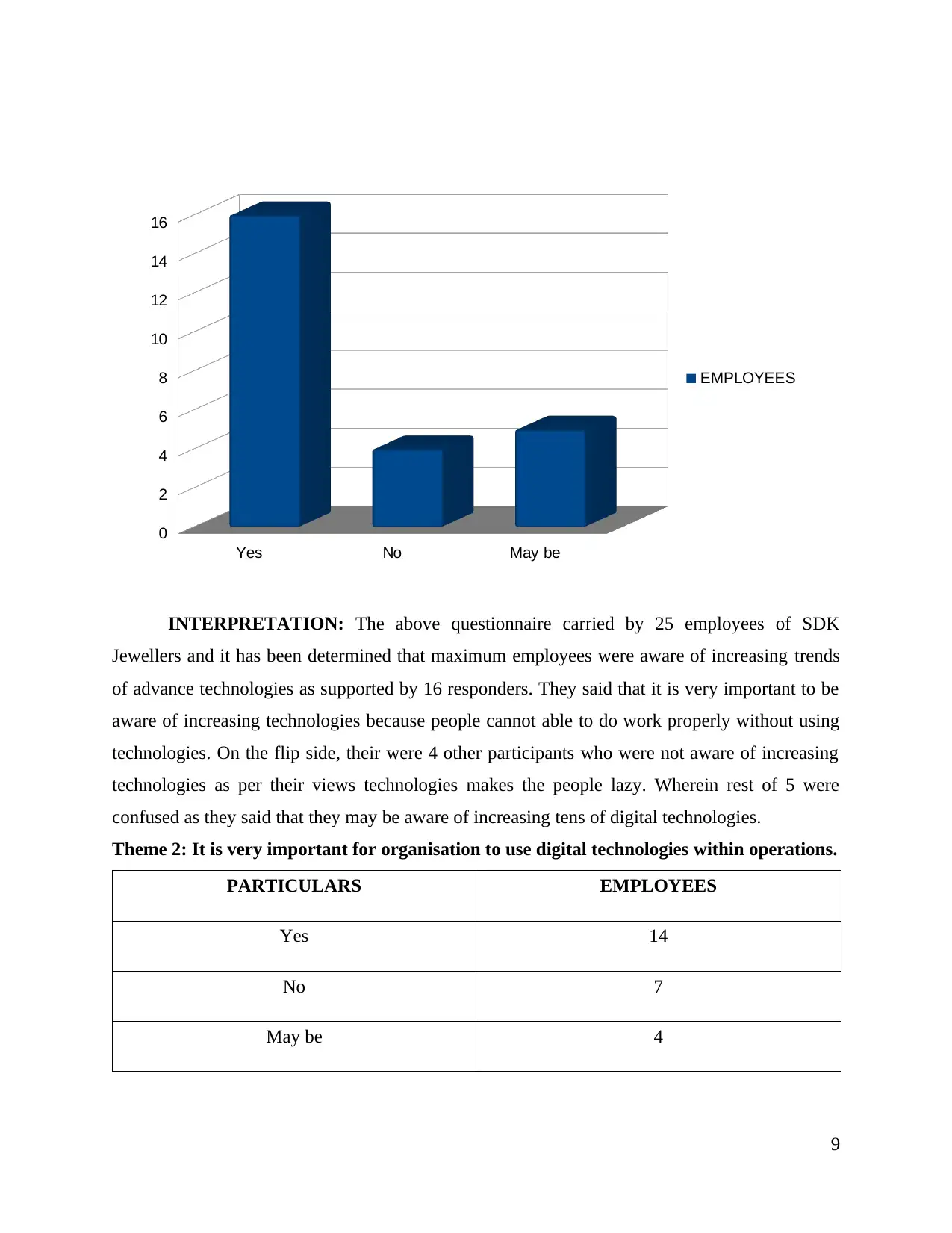
INTERPRETATION: The above questionnaire carried by 25 employees of SDK
Jewellers and it has been determined that maximum employees were aware of increasing trends
of advance technologies as supported by 16 responders. They said that it is very important to be
aware of increasing technologies because people cannot able to do work properly without using
technologies. On the flip side, their were 4 other participants who were not aware of increasing
technologies as per their views technologies makes the people lazy. Wherein rest of 5 were
confused as they said that they may be aware of increasing tens of digital technologies.
Theme 2: It is very important for organisation to use digital technologies within operations.
PARTICULARS EMPLOYEES
Yes 14
No 7
May be 4
9
Yes No May be
0
2
4
6
8
10
12
14
16
EMPLOYEES
Jewellers and it has been determined that maximum employees were aware of increasing trends
of advance technologies as supported by 16 responders. They said that it is very important to be
aware of increasing technologies because people cannot able to do work properly without using
technologies. On the flip side, their were 4 other participants who were not aware of increasing
technologies as per their views technologies makes the people lazy. Wherein rest of 5 were
confused as they said that they may be aware of increasing tens of digital technologies.
Theme 2: It is very important for organisation to use digital technologies within operations.
PARTICULARS EMPLOYEES
Yes 14
No 7
May be 4
9
Yes No May be
0
2
4
6
8
10
12
14
16
EMPLOYEES
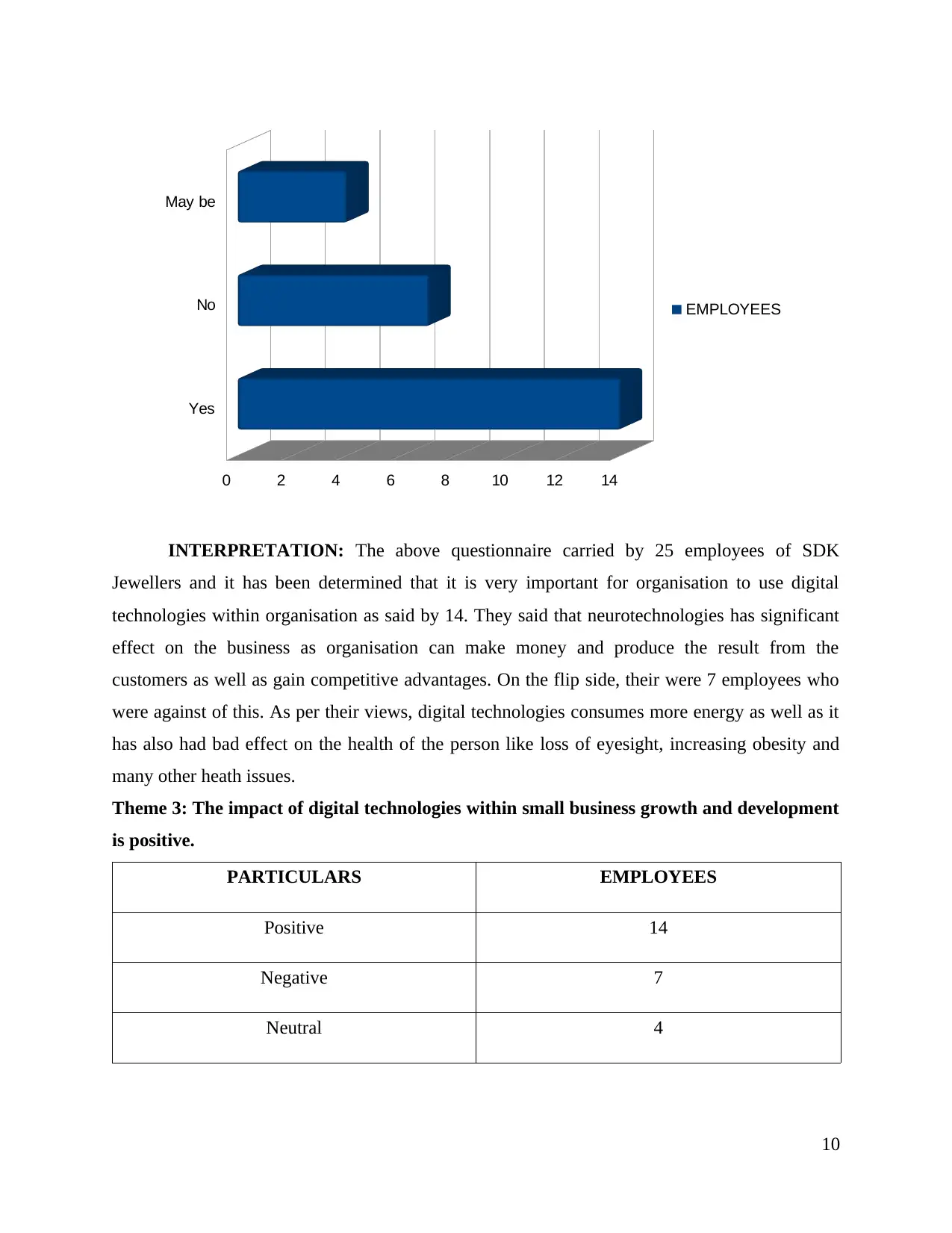
INTERPRETATION: The above questionnaire carried by 25 employees of SDK
Jewellers and it has been determined that it is very important for organisation to use digital
technologies within organisation as said by 14. They said that neurotechnologies has significant
effect on the business as organisation can make money and produce the result from the
customers as well as gain competitive advantages. On the flip side, their were 7 employees who
were against of this. As per their views, digital technologies consumes more energy as well as it
has also had bad effect on the health of the person like loss of eyesight, increasing obesity and
many other heath issues.
Theme 3: The impact of digital technologies within small business growth and development
is positive.
PARTICULARS EMPLOYEES
Positive 14
Negative 7
Neutral 4
10
Yes
No
May be
0 2 4 6 8 10 12 14
EMPLOYEES
Jewellers and it has been determined that it is very important for organisation to use digital
technologies within organisation as said by 14. They said that neurotechnologies has significant
effect on the business as organisation can make money and produce the result from the
customers as well as gain competitive advantages. On the flip side, their were 7 employees who
were against of this. As per their views, digital technologies consumes more energy as well as it
has also had bad effect on the health of the person like loss of eyesight, increasing obesity and
many other heath issues.
Theme 3: The impact of digital technologies within small business growth and development
is positive.
PARTICULARS EMPLOYEES
Positive 14
Negative 7
Neutral 4
10
Yes
No
May be
0 2 4 6 8 10 12 14
EMPLOYEES
⊘ This is a preview!⊘
Do you want full access?
Subscribe today to unlock all pages.

Trusted by 1+ million students worldwide
1 out of 25
Related Documents
Your All-in-One AI-Powered Toolkit for Academic Success.
+13062052269
info@desklib.com
Available 24*7 on WhatsApp / Email
![[object Object]](/_next/static/media/star-bottom.7253800d.svg)
Unlock your academic potential
Copyright © 2020–2025 A2Z Services. All Rights Reserved. Developed and managed by ZUCOL.




